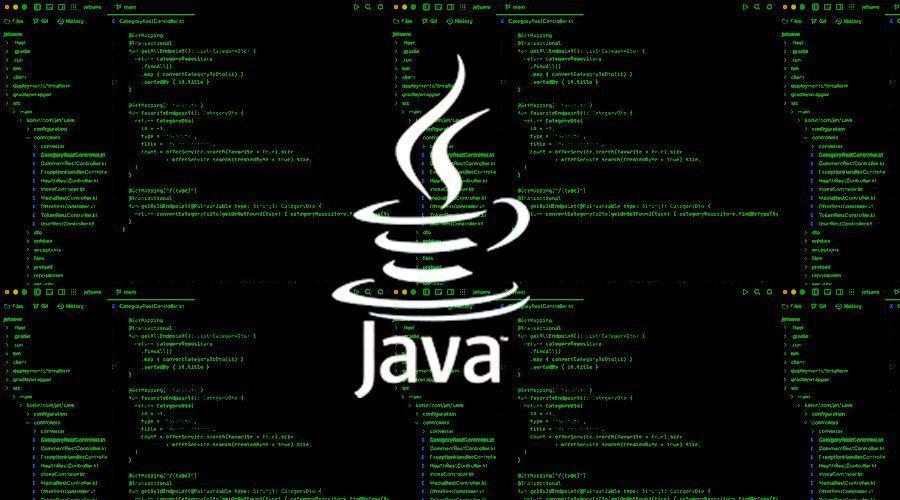
In the fast-paced world of technology, Java has remained a stalwart, consistently evolving to meet the demands of modern software creation.
As we step into 2023, it’s time to take a close look at the state of Java development. From its role in cutting-edge technologies to the latest language enhancements, this article dives deep into the ever-expanding universe of Java.
Java’s Resilience in a Changing Landscape
Java, a programming language first introduced by Sun Microsystems in 1995, has proven its enduring relevance and widespread adoption over the years. Despite the ever-evolving landscape of technology and programming languages, Java has managed to not only survive but thrive, cementing its status as a stalwart in the world of software development. Its robustness, portability, and versatility have contributed to its sustained popularity, making it a go-to choice for a wide range of applications, from web and mobile development to enterprise-level software.
The demand for custom Java programming services has consistently remained high, and this trend shows no sign of diminishing. Organizations and developers continue to turn to the language for its ability to build scalable and reliable solutions, particularly in complex and mission-critical systems. Its extensive ecosystem, including libraries, frameworks, and a vast developer community, further supports its enduring appeal. As technology continues to advance, Java remains a dependable and adaptable choice, ensuring that it will remain a vital tool for developers and businesses alike in the foreseeable future.
Its resilience can be attributed to several key factors:
Cross-Platform Compatibility
The cross-platform compatibility of the language is undoubtedly one of its most significant advantages, and it has stood the test of time. The “Write Once, Run Anywhere” (WORA) philosophy, which Java pioneered, remains a cornerstone of the language’s enduring appeal. Developers can craft their code on one platform, and thanks to the Java Virtual Machine (JVM), it can seamlessly execute on a variety of operating systems. This platform independence not only saves development time but also extends the reach of Java applications, ensuring they can run on different devices and environments with minimal modifications.
Strong Ecosystem
The strong ecosystem surrounding Java further solidifies its position in the software development landscape. The language offers a treasure trove of libraries, frameworks, and tools that cater to a wide spectrum of applications and domains. Whether you’re building dynamic web applications, robust mobile apps, or diving into data analytics, Java’s extensive ecosystem equips software engineers with the necessary resources to streamline development and maintain high-quality standards. This rich toolkit empowers developers to tackle complex projects with confidence, making this language a top choice for diverse development needs.
Enterprise-Grade Reliability
Java’s reputation for enterprise-grade reliability remains unshaken in 2023. It has long been the preferred choice for businesses and organizations dealing with mission-critical applications. The maturity, stability, and proven track record of the language have earned the trust of enterprises worldwide. Its scalability, exceptional security features, and consistent performance have made it the backbone of many large-scale applications that demand unwavering reliability. As businesses continue to prioritize the development of reliable and secure software, Java continues to stand tall as the dependable and time-tested solution to meet these critical demands.
Java’s Role in Emerging Technologies
Java’s adaptability is showcased in its involvement in various cutting-edge technologies:
Machine Learning and AI
While Python has traditionally held the spotlight in the realm of machine learning and artificial intelligence, Java is steadily carving out its niche in this ever-evolving field. Its foray into machine learning is facilitated by libraries like Deeplearning4j, which provide a robust platform for creating and deploying machine learning models. Additionally, frameworks like Apache OpenNLP empower developers to harness the power of natural language processing (NLP) and sentiment analysis within applications. This expansion of Java’s capabilities into machine learning and AI showcases its adaptability to meet the demands of cutting-edge technologies.
Internet of Things (IoT)
In the fast-growing Internet of Things (IoT) landscape, Java has emerged as a significant player. Its lightweight nature, efficient memory management, and compatibility with embedded systems make it an ideal choice for IoT development. The support for IoT protocols such as MQTT and CoAP ensures seamless communication between IoT devices and cloud-based services. This, combined with the extensive ecosystem and developer community, positions the language as a powerful tool for creating smart and interconnected IoT solutions. The ability of the language to handle the diverse requirements of IoT devices, from sensors to gateways, underscores its versatility in this burgeoning field.
Cloud-Native Java
With the rise of cloud computing, Java has adapted to the changing IT landscape by embracing cloud-native technologies. Its compatibility with containerization platforms like Kubernetes and Docker has made it a formidable contender for developing cloud-native applications. Frameworks such as Spring Boot have simplified the development of microservices, enabling developers to build scalable and resilient cloud-native solutions efficiently. This evolution aligns the language with modern software development practices, making it a top choice for organizations looking to harness the benefits of cloud-native architectures, such as elasticity, containerization, and continuous integration/continuous deployment (CI/CD), in their applications. Its seamless integration with these cloud-native tools positions the language as a forward-looking language that can drive innovation in cloud-based environments.
Java Language Enhancements
The evolution of the language continues with regular updates that introduce new features and improve the language. In 2023, developers can look forward to the following enhancements:
Pattern Matching
Pattern matching, introduced in Java 16, simplifies code by allowing engineers to destructure objects and write more concise and readable code. This feature enhances code clarity and maintainability.
Records
Java records, introduced in version 16, provide a concise way to define classes that are primarily used to store data. They automatically generate constructors, accessor methods, and more, reducing boilerplate code.
Project Loom
Project Loom, expected in a future Java release, aims to simplify concurrency by introducing lightweight, user-mode threads called “fibers.” This will make it easier to write highly concurrent and efficient code in Java.
Tools and Frameworks
Java software engineering in 2023 is complemented by a rich set of tools and frameworks that streamline the development process:
Integrated Development Environments (IDEs)
Popular IDEs like IntelliJ IDEA, Eclipse, and NetBeans continue to provide robust support for Java development. They offer code suggestions, debugging capabilities, and integration with build tools.
Build Tools
Apache Maven and Gradle remain essential for managing project dependencies and building applications efficiently. They simplify the build process and provide a structured project layout.
Testing Frameworks
JUnit and TestNG continue to be the go-to choices for unit testing. These frameworks enable developers to write and execute tests to ensure the reliability of their code.
If you have challenges with the project implementation or lacks in-house expertise, turn to expert Java consulting services. Professional consultants are experienced with the latest tools and can bring fresh insights to the table, helping you overcome the hurdles and ultimately leading to a more efficient and robust software solution.
The Rise of Java in Mobile Development
The presence of the language in mobile app development is not new, but it’s gaining renewed momentum in 2023:
Android Development
Android, the world’s most popular mobile operating system, relies heavily on Java for app development. Kotlin, a language that interoperates seamlessly with Java, has also gained popularity among Android programmers.
Cross-Platform Development
Cross-platform capabilities extend to mobile app development with frameworks like Xamarin and Codename One. These tools allow developers to write code once and deploy it on both Android and iOS platforms.
Security and Java
Security is a top priority in today’s interconnected world, and Java is addressing this concern:
Security Updates
Oracle and the Java community consistently release security updates to address vulnerabilities. Staying up-to-date with these patches is essential for maintaining a secure environment.
Security Libraries
The language boasts a range of security libraries and tools that help developers implement secure coding practices. Libraries like Bouncy Castle and OWASP Java Encoder are invaluable for building secure applications.
Conclusion
Java’s journey through the years has been nothing short of remarkable. In 2023, it continues to prove its relevance in an ever-evolving tech landscape. With its cross-platform compatibility, adaptability to emerging technologies, language enhancements, and robust ecosystem, Java remains a top choice for developers and enterprises worldwide.
As we move forward, Java’s role in areas such as machine learning, IoT, and cloud-native development will likely expand further, making it a language that software engineers should keep on their radar. With the continuous improvement of tools, frameworks, and security measures, Java development is set to thrive for years to come.
Frequently Asked Questions (FAQs)
Is Java still a relevant programming language in 2023?
Absolutely. The language remains highly relevant in 2023, with a strong presence in various domains, including web development, mobile app development, IoT, and cloud-native applications.
What are the key enhancements in recent Java versions?
Recent versions have introduced features like pattern matching, records, and upcoming projects like Project Loom, which enhance code readability, maintainability, and concurrency management.
Can I use Java for machine learning and AI development?
Yes, the language is increasingly used for machine learning and AI, with libraries like Deeplearning4j and frameworks like Apache OpenNLP providing tools for these domains.
How does Java address security concerns in 2023?
The language addresses security concerns through regular security updates and a rich set of security libraries and tools that help developers implement secure coding practices.
What are the options for mobile app development using Java?
Java is used for Android app development, and you can also explore cross-platform development using tools like Xamarin and Codename One to target both Android and iOS platforms.
- Broadway’s Rising Stars Converge: A Day Of Inspiration At Broadway Express y Más
- Adams, Hochul And More Toast $5 Billion Housing Plan: Building Dreams Together!
- Alicia Graf Mack, Dancer, Educator, And Leader Appointed Artistic Director Of Ailey
- Update: More Illnesses Have Been linked To The McDonald’s E. Coli Outbreak
- Bronx: NYWF’s 30th Annual Dinner Honors Community Leadership And Purpose
Become a Harlem Insider!
By submitting this form, you are consenting to receive marketing emails from: . You can revoke your consent to receive emails at any time by using the SafeUnsubscribe® link, found at the bottom of every email. Emails are serviced by Constant Contact









